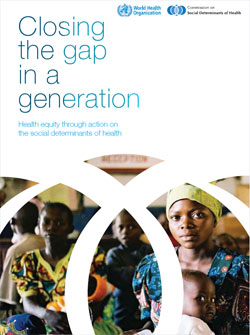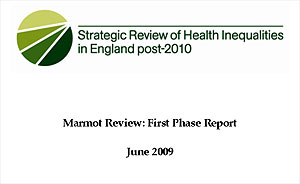 |
 |
|
Professor Sir Michael Marmot (professor of Epidemiology and Public Health at University College London), has been asked by the government to undertake a major review of health inequalities.
The review has four tasks: The review follows the publication in 2008 of ‘Closing the Gap in a Generation’. This is the report from the Global Commission on Social Determinants of Health (CSDH), also chaired by Professor Sir Michael Marmot and published by the World Health Organisation. The review will draw on both international and national evidence of successful interventions to reduce health inequalities and to develop recommendations from 2010. The first report into the health review was published in June of this year, but has not been given widespread publicity.
Page 80 & 81 deal with the issue of employment, working conditions and the relationship to physical and mental health: "Employment and working conditions have powerful effects on health and health equity. When these are good they can provide financial security, social status, personal development, social relations and self-esteem, and protection from physical and psychosocial hazards – each important for health (Marmot & Wilkinson, 2006). In addition to the direct health consequences of tackling work-related inequities, the health equity impacts will be even greater due to work’s potential role in reducing gender, ethnic, racial, and other social inequities." Commenting upon work and health inequalities the report states: It also points out the issue of working conditions: "The conditions of work also affect health and health equity. Poor work quality may affect mental health almost as much as loss of work (Bartley, 2005; Muntaner et al., 1995; Strazdins et al., 2007). Adverse conditions that expose individuals to a range of health hazards tend to cluster in lower-status occupations." On health and safety at work it says: The WHO says: "The social determinants of health are the conditions in which people are born, grow, live, work and age, including the health system. These circumstances are shaped by the distribution of money, power and resources at global, national and local levels, which are themselves influenced by policy choices. The social determinants of health are mostly responsible for health inequities - the unfair and avoidable differences in health status seen within and between countries." It further explains on its website: "Responding to increasing concern about these persisting and widening inequities, WHO established the Commission on Social Determinants of Health (CSDH) in 2005 to provide advice on how to reduce them. The Commission's final report was launched in August 2008, and contained three overarching recommendations: Employment and working conditions have powerful effects on health equity. When these are good, they can provide financial security, social status, personal development, social relations and self-esteem, and protection from physical and psychosocial illness. The Commission calls for:
Further information can be found on the World Health Organisation's website at: Professor Sir Michael Marmot's review document discusses the outcome so far of the review and details proposals in tackling social inequality and hence health inequality. In doing so, many of the arguments put over by Union Safety Reps and the Trade Union movement in general can be seen within the 52 page review document:
The second dimension is to ensure a better work-life balance for those in work, both to reduce work-related stress and to make it easier for some groups to be in suitable work (e.g. lone parents).In addition to tailoring the proposals for fairer employment to the specific issues around work-life balance, this would involve building much greater flexibility and support into work and working time. Third, in promoting the availability of “good work” the proposals focus on participation, control and reward and enforcing protection of workers from physical and psycho-social hazards (e.g. poor management practices, bullying, etc). More specifically some Task Groups also proposed that greater professional autonomy and empowerment of those working in the professions dealing with the care of the vulnerable and the development and education of children, as central to the effective delivery of the services on which many citizens depend directly or indirectly." It goes further: " ................. In assessing the potential use of regulation in areas such as health behaviour, employment conditions and environmental sustainability, policymakers need to consider whether other methods such as support and incentives proved ineffective and whether the cost (to the individuals or organisations) justifiable in terms of the potential gains." Download the WHO report Closing the Gap in a Generation and The Marmot Review First Phase report from The World Health Organisation website pages on this subject: World Health Organisation Source: WHO / UCL / Unionsafety
|
 The review presents an exciting opportunity to propose an evidence-based strategy for reducing health inequalities from 2010. The strategy will include policies and interventions that address the social determinants of health inequalities.
The review presents an exciting opportunity to propose an evidence-based strategy for reducing health inequalities from 2010. The strategy will include policies and interventions that address the social determinants of health inequalities.  The background to this is the WHO report, ‘Closing the Gap in a Generation’, which makes interesting reading for those concerned with workplace health, safety and welfare.
The background to this is the WHO report, ‘Closing the Gap in a Generation’, which makes interesting reading for those concerned with workplace health, safety and welfare. "Three dimensions are highlighted in the proposals. First, moving toward fairer employment by providing greater job security, reducing the cliff edge distinction between being in and out of work and reducing long term unemployment and the detrimental effects this has on mental and physical health.
"Three dimensions are highlighted in the proposals. First, moving toward fairer employment by providing greater job security, reducing the cliff edge distinction between being in and out of work and reducing long term unemployment and the detrimental effects this has on mental and physical health.